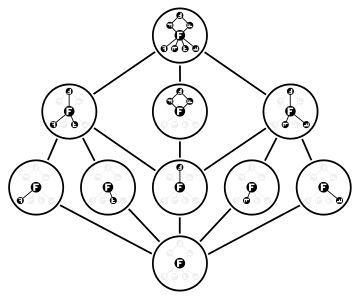Risk premium

In the 3-element layer are the maximal subgroups;
their intersection (the F. s.) is the central element in the 5-element layer.
So Dih4 has only one non-generating element beyond e.
In mathematics, the Frattini subgroup Φ(G) of a group G is the intersection of all maximal subgroups of G. For the case that G has no maximal subgroups, for example the trivial group e or the Prüfer group, it is defined by Φ(G) = G. It is analogous to the Jacobson radical in the theory of rings, and intuitively can be thought of as the subgroup of "small elements" (see the "non-generator" characterization below). It is named after Giovanni Frattini, who defined the concept in a paper published in 1885.
Some facts
- Φ(G) is equal to the set of all non-generators or non-generating elements of G. A non-generating element of G is an element that can always be removed from a generating set; that is, an element a of G such that whenever X is a generating set of G containing a, X − {a} is also a generating set of G.
- Φ(G) is always a characteristic subgroup of G; in particular, it is always a normal subgroup of G.
- If G is finite, then Φ(G) is nilpotent.
- If G is a finite p-group, then Φ(G) = Gp [G,G]. Thus the Frattini subgroup is the smallest (with respect to inclusion) normal subgroup N such that the quotient group G/N is an elementary abelian group, i.e., isomorphic to a direct sum of cyclic groups of order p. Moreover, if the quotient group G/Φ(G) (also called the Frattini quotient of G) has order pk, then k is the smallest number of generators for G (that is the smallest cardinality of a generating set for G). In particular a finite p-group is cyclic if and only if its Frattini quotient is cyclic (of order p). A finite p-group is elementary abelian if and only if its Frattini subgroup is the trivial group, Φ(G) = e.
- If H and K are finite, then Φ(HxK) = Φ(H)x Φ(K).
An example of a group with nontrivial Frattini subgroup is the cyclic group G of order p2, where p is prime, generated by a, say; here, .
See also
References
- 20 year-old Real Estate Agent Rusty from Saint-Paul, has hobbies and interests which includes monopoly, property developers in singapore and poker. Will soon undertake a contiki trip that may include going to the Lower Valley of the Omo.
My blog: http://www.primaboinca.com/view_profile.php?userid=5889534 (See Chapter 10, especially Section 10.4.)
